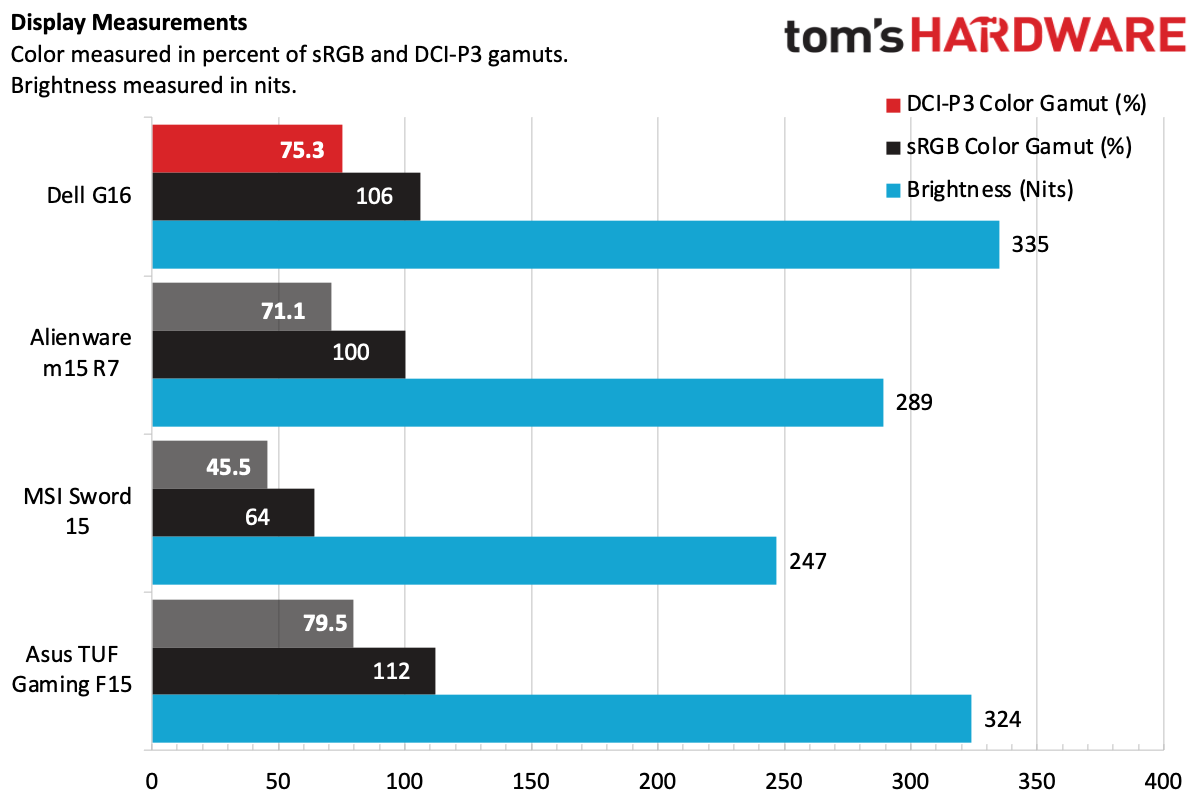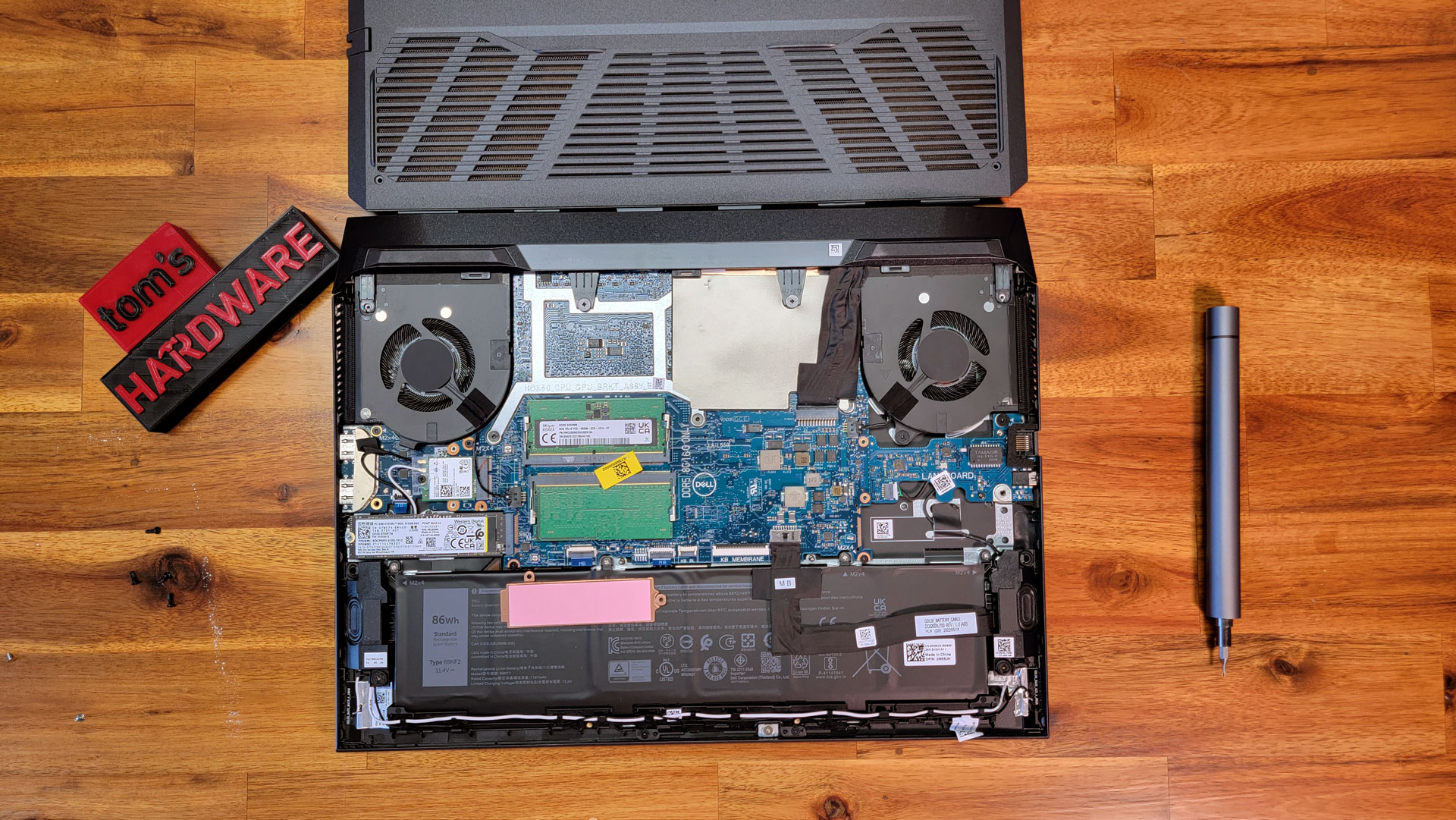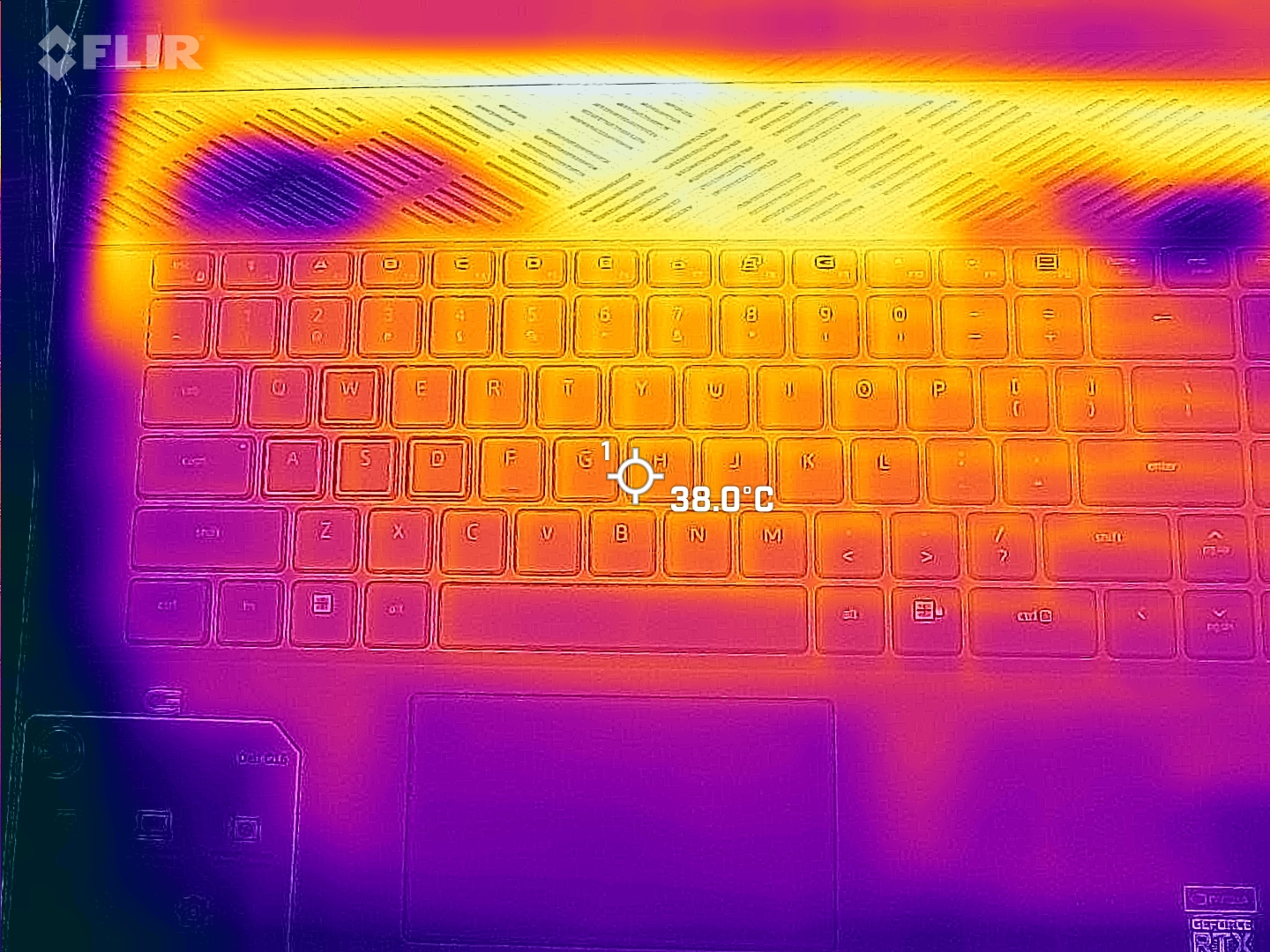Tom's Hardware Verdict
The Dell G16 has a big, bright 165 Hz display (for its class, anyway) with a sturdy aluminum lid. While it offers strong gaming performance, the webcam, keyboard and mouse could all use improvement.
Pros
- +
Sturdy design with aluminum construction
- +
Bright display for its class with 165 Hz refresh rate
- +
Strong gaming performance
Cons
- -
Lackluster keyboard and touchpad
- -
Poor webcam
Why you can trust Tom's Hardware
The 16-inch laptop is in vogue. Several companies have moved from 15 to 16-inch laptops, especially in the productivity space. With the Dell G16 (7620) ($1,139.99 to start, $1,499.99 as tested and you may get it for less with a Dell coupon), we're seeing this slightly-larger screen size make its way into gaming.
The Dell G16 also brings an aluminum lid, which you often don't find on the best gaming laptops under $1,500 that makes it feel premium. The 16-inch, 2560 x 1600 screen has a 165 Hz refresh rate, and you may even be able to take advantage of that in some games with the Nvidia GeForce RTX 3060 we tested with.
There are still a few trappings of budget gaming notebooks here, like a really stiff touchpad and a truly mediocre webcam, but if you're looking for a gaming notebook that's less than $2,000 and has a bit more screen space, it's certainly one to consider.
Design of the Dell G16
As far as budget and mid-level gaming PCs go, the G16 is an odd, though totally unobtrusive design. When it's closed, it's like a mullet: business in the front, party in the back. I should probably explain that.

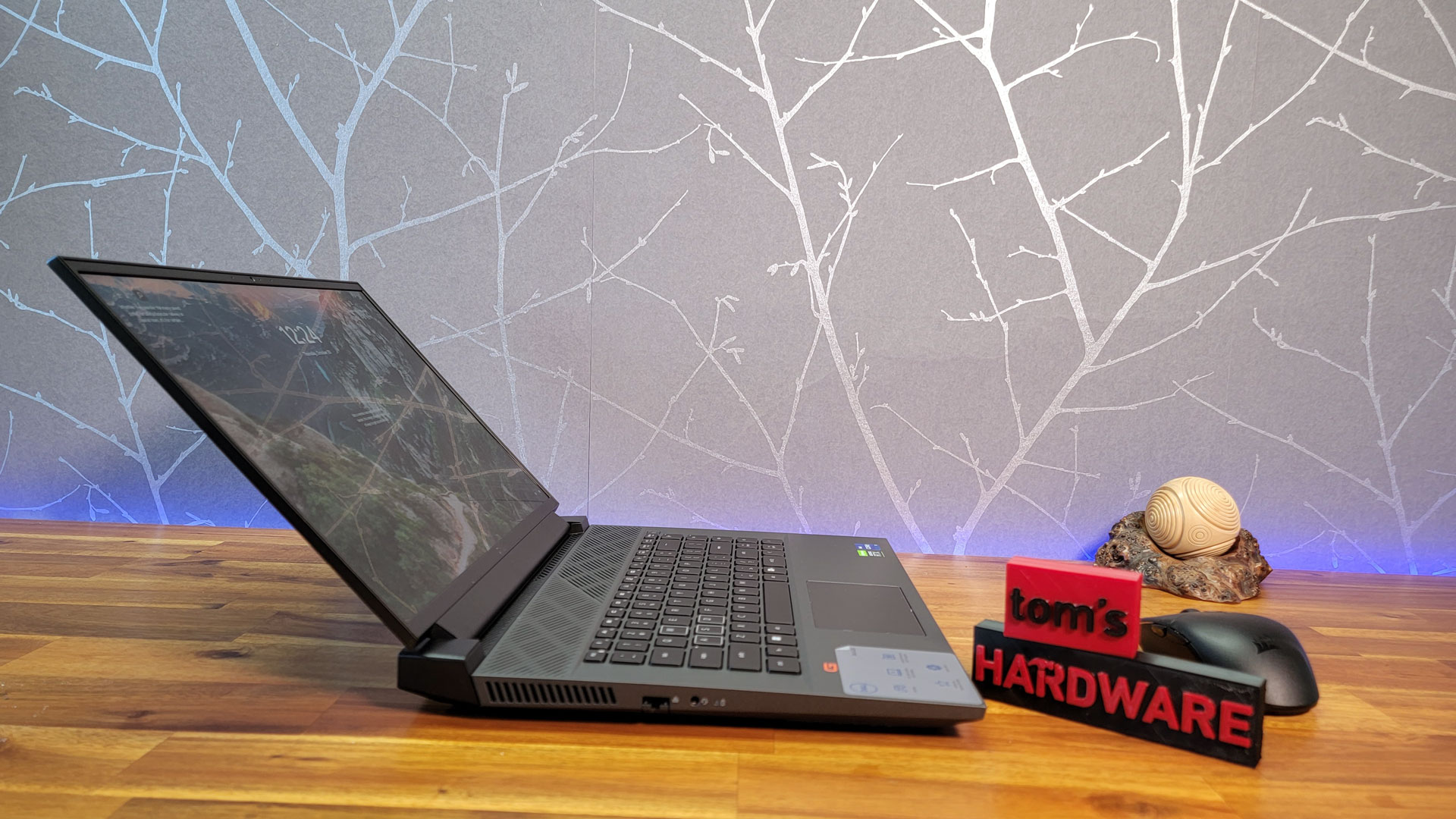

The front reminds me of one of Dell's Latitude business laptops. It's "obsidian" black with a Dell logo, but not much else going on. Surprisingly, the lid is metal, giving it a surprisingly luxurious feel at this price point. (The bottom and the keyboard deck are plastic, which is common for gaming notebooks.)
But the back of the laptop has a bump with ports on it, as well as some angular venting. This is more like Dell's premium "Alienware" lineup, which has been putting ports there for years.
When you lift the lid, things get a bit more interesting. The 16-inch display is surrounded by a moderate bezel, but what really caught my eye was the cross-hatch ventilation design. While some of my colleagues shrugged it off, I think it's a cool look.
The keyboard has single-zone lighting (at least, in our review unit. See the configurations section below), so you can only pick one color to backlight your keyboard.
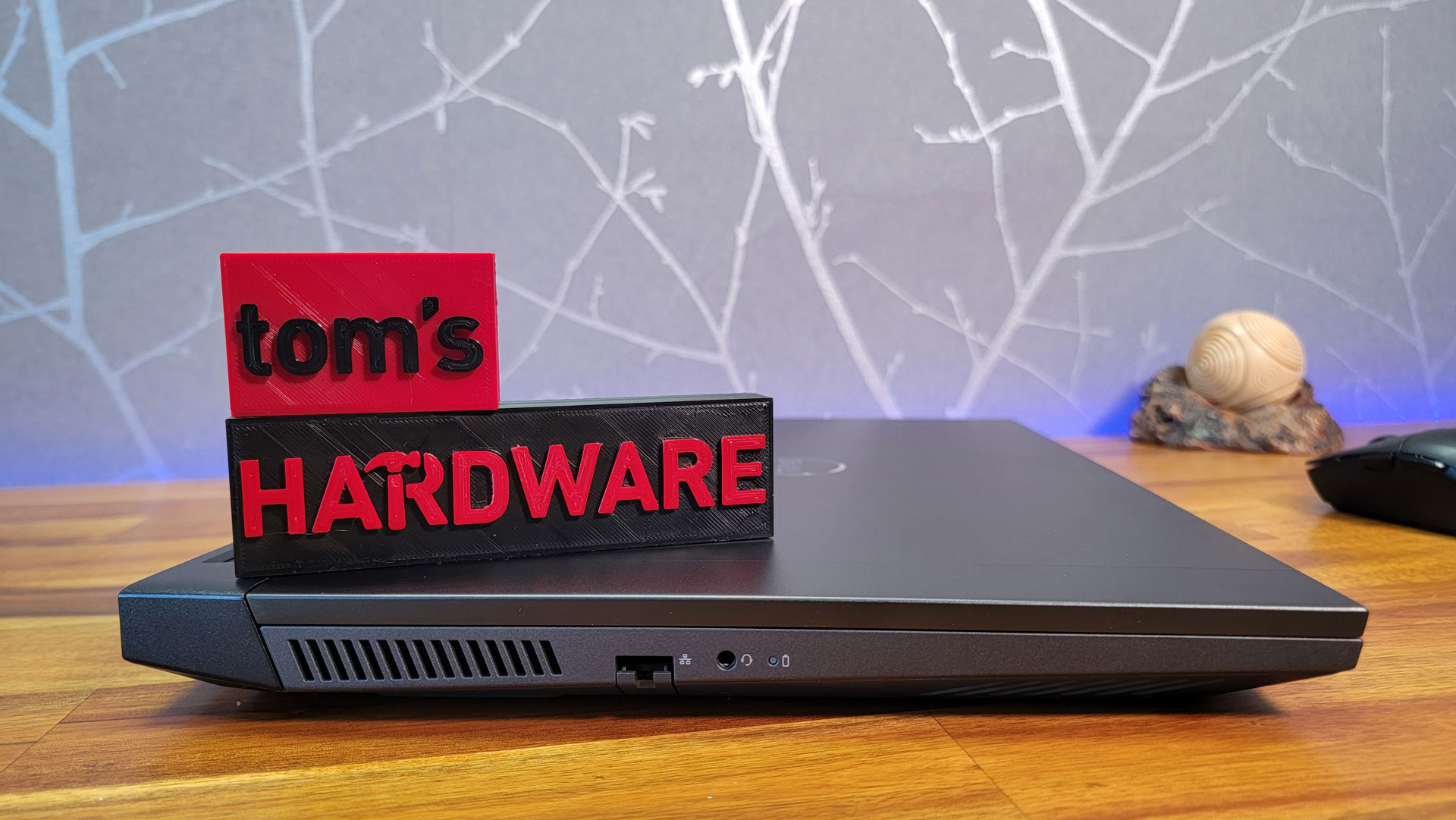

There are ports on three sides of the Dell G16. The left side has the Ethernet jack and 3.5 mm audio port, while the right edge has a pair of USB 3.2 Gen 1 Type-A ports. On the back, there's a Thunderbolt 4 port, a third USB Type-A port, the HDMI output and the power jack. There's some weird spacing between them, but you won't be looking too often anyway.
Dell's 16-inch gaming notebook measures 14.06 x 10.71 x 1.06 inches (357.26 x 272.11 x 26.90 mm). Our unit weighed 5.72 pounds, though Dell's site says the laptop starts at 5.38 pounds and goes up to 5.95 pounds. It's very close in size to the Alienware m15 R7 (14.02 x 10.73 x 0.94 inches, 5.34 pounds) and MSI Sword 15 (14.13 x 10.20 x 0 . 98 inches, 4.96 pounds), but the G16 is a bit heavier and thicker. Asus' TUF Gaming F15 at 13.94 x 9.88 x 0.78 inches and 4.41 pounds is the smallest of the bunch.
Dell G16 Specifications
| CPU | Intel Core i7-12700H |
| Graphics | Nvidia GeForce RTX 3060 (6GB GDDR6, 130W, 1,702 MHz Boost Clock |
| Memory | 16GB DDR5-4800 |
| Storage | 512GB M.2 PCIe NVMe SSD |
| Display | 16-inch, 2560 x 1600, 16:10, 165 Hz |
| Networking | Intel Wi-Fi 6 AX201, Bluetooth 5.2 |
| Ports | Thunderbolt 4 over USB Type-C, 3x USB 3.2 Gen 1 Type-A, HDMI 2.1, Ethernet, 3.5 mm headphone jack |
| Camera | 720p |
| Battery | 86 WHr |
| Power Adapter | 240 W |
| Operating System | Windows 11 Home |
| Dimensions (WxDxH) | 14.06 x 10.71 x 1.06 inches (357.26 x 272.11 x 26.90 mm) |
| Weight | 5.72 pounds (2.59 kg) |
| Price (as configured) | $1,499.99 |
Gaming and Graphics on the Dell G16
With its Nvidia GeForce RTX 3060 and an Intel Core i7-12700H, we expected our Dell G16 to run our benchmarks successfully, even at its native 2560 x 1600. We weren't disappointed, though other laptops were extremely competitive.
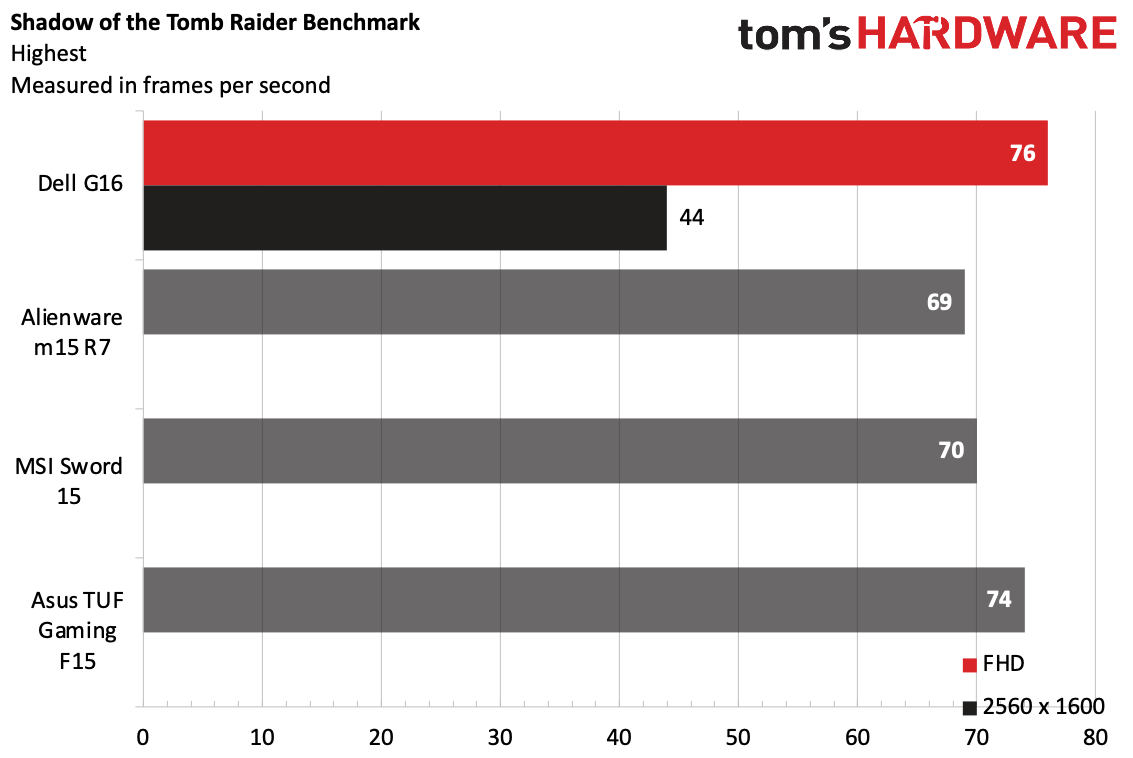

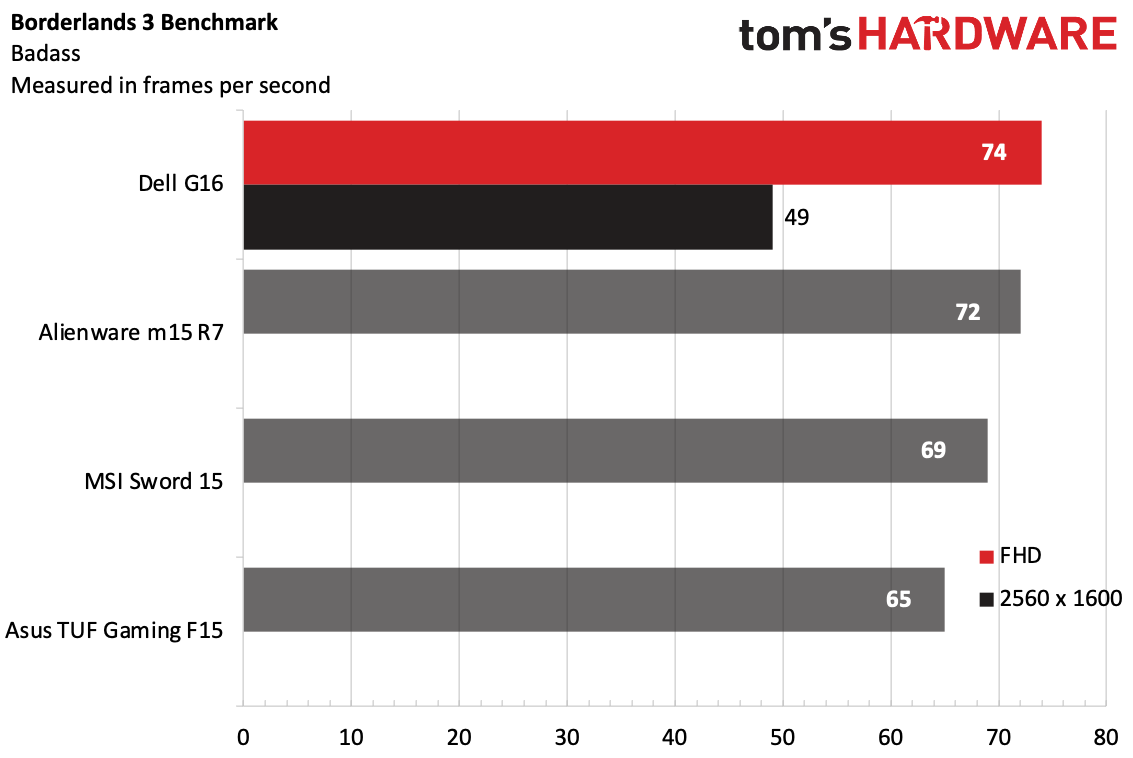

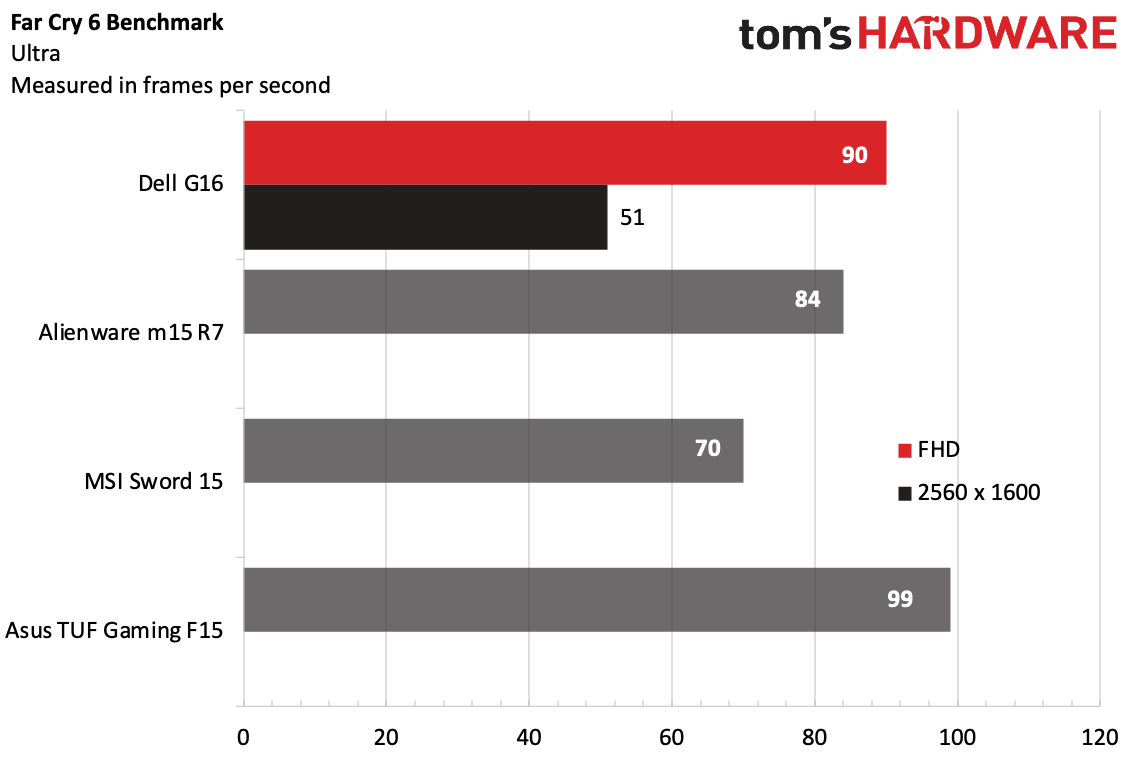
I played some Guardians of the Galaxy on the Dell G16 to put it through its paces. In a section in which you land Star-Lord's ship, the Milano, the game ran between 92-117 frames per second on medium settings at 1920 x 1200 (I used this instead of 1080p to take advantage of the screen real estate). Platforming sections of the game typically ran between 90 and 102 fps, though sections with lots of effects could drop it down as low as the 70's. You might be able to play this game at higher settings, but doing so here allowed me to take at least some advantage of the 165 Hz screen and play above 60 fps while actually seeing the benefits.
On the Shadow of the Tomb Raider benchmark (very high settings), the Dell G16 played at 76 fps at 1080p and 44 fps at its native 1600p. The other laptops, all with 1080p screens, were at least a few frames behind, with the m15 R7 falling the furthest at 69 fps.
Grand Theft Auto V (very high settings) drew strong performances from all four laptops at 1080p. The G16 hit 94 fps, while the Alienware beat it by a frame. The Sword and TUF Gaming both hit 90 fps. At 1600p, the G16 reached 54 fps.
On Far Cry 6, the G16 reached 90 frames per second on the benchmark at ultra settings (51 fps at 2560 x 1600). The TUF won here, at 99 fps.
Red Dead Redemption 2 on medium is still a challenge. Both the G16 and the Alienawre hit 60 fps at 1080p (the G16 reached 38 fps at its native resolution), while the TUF Gaming reached 59 fps and the Sword played at 57 fps.
The G16 did the best of the group on Borderlands 3 ("badass" settings), playing at 74 fps at 1080p and 49 fps at 1600p. The R7 came the next closest at 72 fps, while the TUF lagged slightly at 65 fps.
We stressed test the G16 by looping Metro Exodus 15 times on the RTX preset. The laptop ran the game at an average of 59.76 fps and was surprisingly stable throughout the test. During that gauntlet, the CPU's six performance cores ran at 2.71 GHz, while the eight efficiency cores ran at 2.16 GHz. The CPU package measured an average of 76.42 degrees Celsius and showed some signs of throttling. The GPU ran at 1.6 GHz and measured 77.16 degrees Celsius.
Productivity Performance on the Dell G16
A gaming laptop wielding a Intel Core i7-12700H, 16GB of RAM and a 512GB SSD should be able to pull double-duty as a workhorse.
Get Tom's Hardware's best news and in-depth reviews, straight to your inbox.
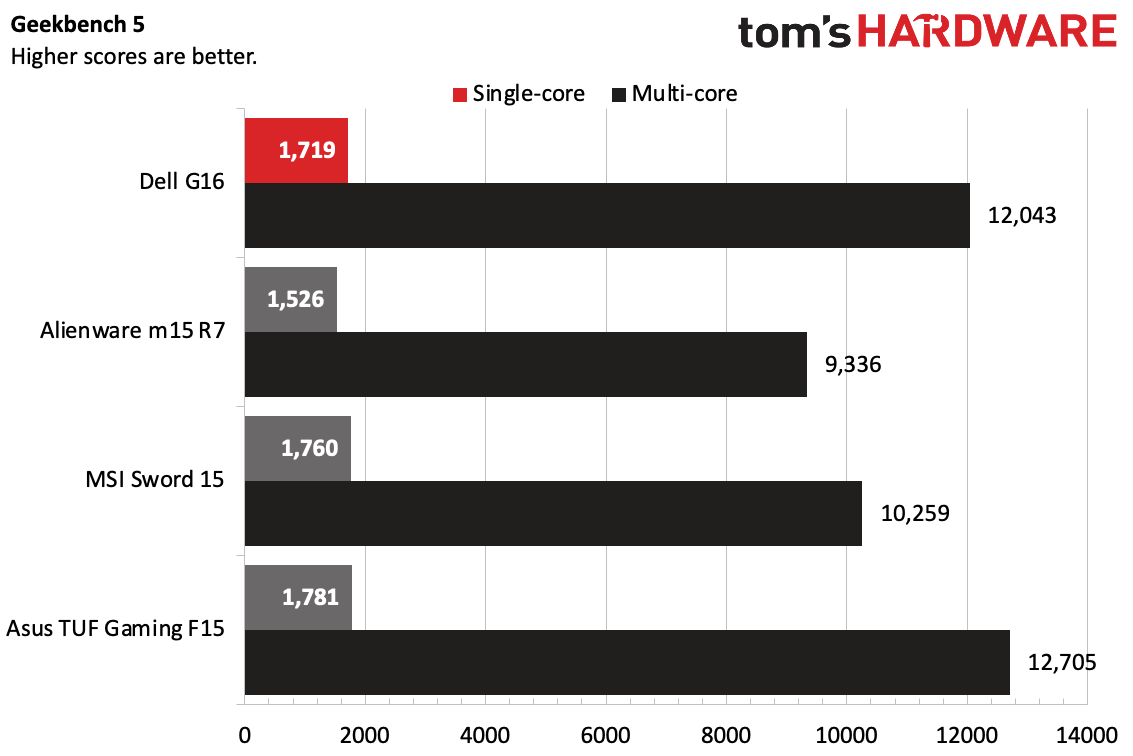
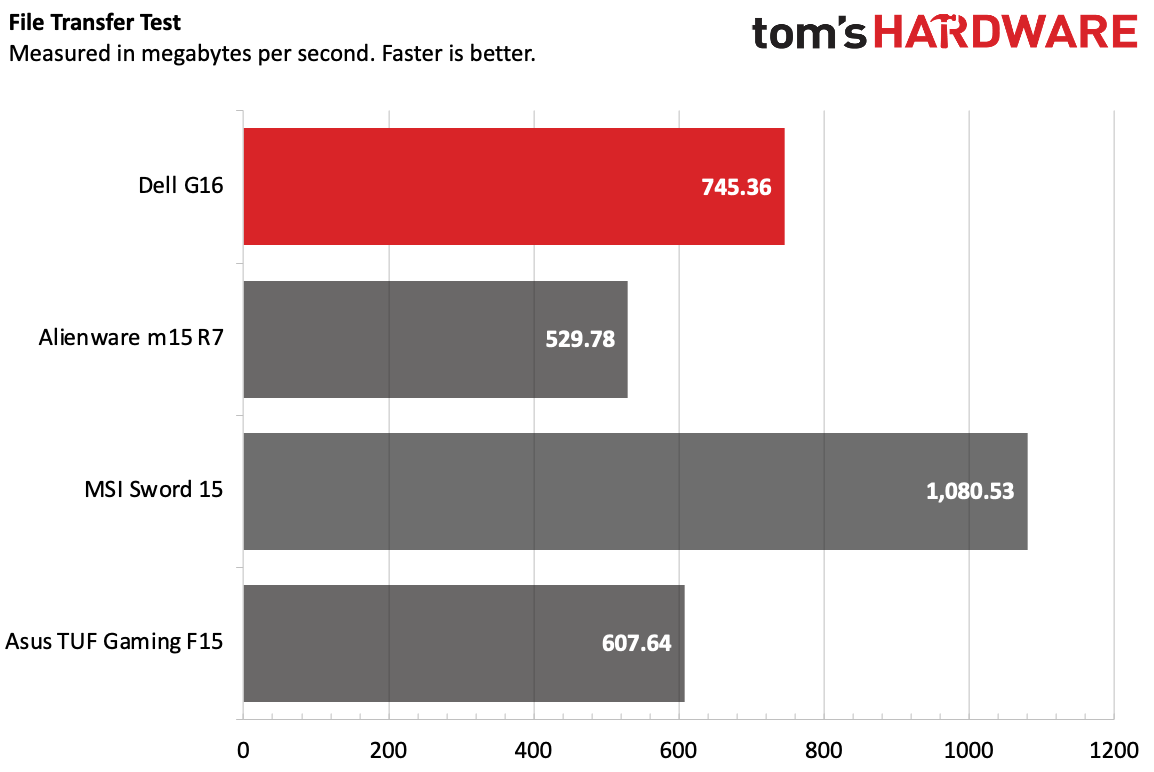
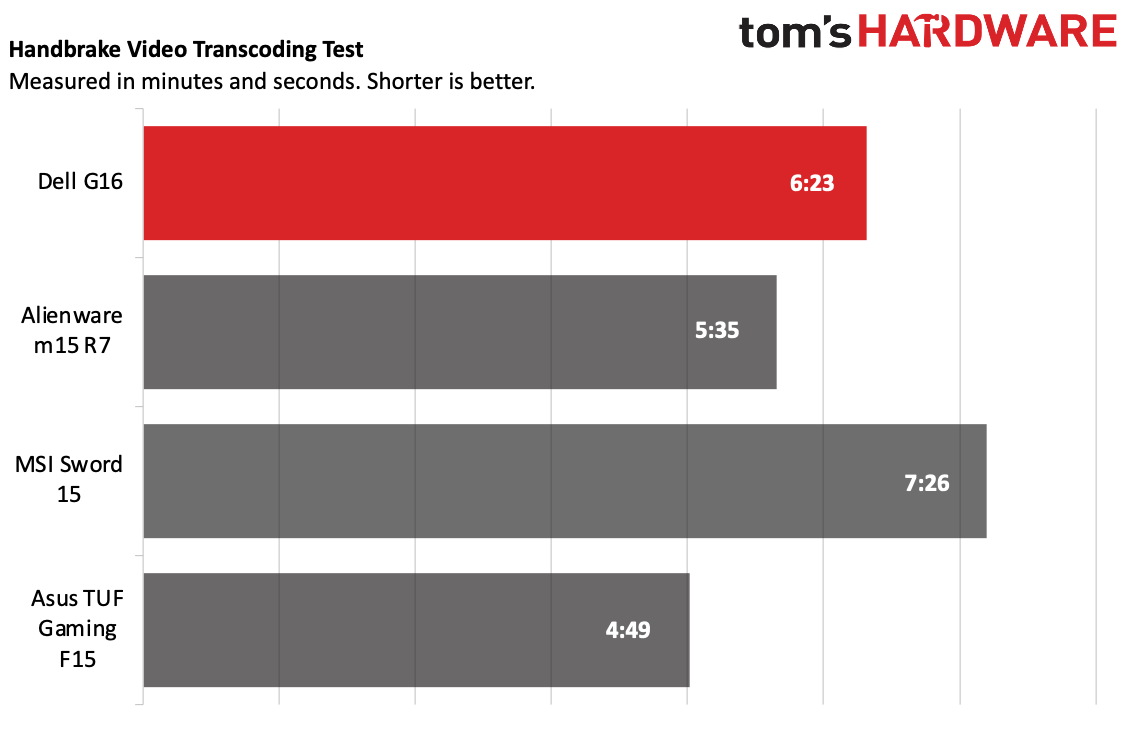
On Geekbench 5, a performance test leaning heavily on CPUs , the Dell achieved a single-core score of 1,719 and a multi-core score of 12,043. Both the TUF Gaming F15 (the same Core i7-12700H) and MSI Sword (i7-12650H) edged it out slightly on single-core, but the MSI fell short on multi-core, leaving the G16 in a slight second palace. The Alienware m15 R7, with an AMD Ryzen 7 6800H, came in last place.
The G16 copied 25GB of files at a rate of 745.36 MBps, which is faster than both the Alienware m15 and the Asus TUF, but the MSI Sword 15 blazed past the group at 1,080.53 MBps.
It took the Dell G16 6 minutes and 23 seconds to transcode a 4K video to 1080p using Handbrake. That's more than a minute faster than the MSI Sword, but both the Alienware and the TUF did it more quickly.
Display on the Dell G16
The display on the Dell G16 is a 16-inch, 2560 x 1600 (with a 16:10 aspect ratio) screen with a 165 Hz refresh rate. It's fairly average among its competitors when it comes to colors, but it does get brighter.
The trailer for Creed 3 looked good on the G16. A sunrise behind actor Jonathan Majors while he works out on Venice Beach was a distinct blend of orange and purple, and the end of the trailer, during what's surely the big fight, Creed's white boxing gloves and shorts (against his foe's black getup — what a duality!) were clean and sharp in contrast.
Dell's screen covers 75.3% of the DCI-P3 color gamut and 106% of the SRGB color space, putting it ever so slightly ahead of Alienware's 15-inch, 1080p panel and a teeny bit behind the one on the Asus TUF Gaming F15. MSI's display was far less vivid on both counts.
The G16 is the brightest of the bunch at 335 nits, surpassing the TUF Gaming (324 nits), Alienware m15 (289 nits) and MSI Sword (247 nits).
Keyboard and Touchpad on the Dell G16
I have very mixed feelings about the Dell G16's keyboard and mouse. As a purely gaming device, they may be serviceable. But if this is your only PC, you're going to have a bad time.
The keyboard is as close to "linear" as a gaming laptop keyboard gets without mechanical keys, but without significant travel, I found myself bottoming out while typing. It's less of a pain while hitting buttons in gaming, but it took significant time to get used to typing on it, and even then it tired my fingers out a bit.
The layout is fairly standard, though five customizable macro keys on the keyboard (F2 through F6, which can be set up in Alienware Command Center) stand out for games, especially the real-time strategy and MMO genres. Volume is located on the right side, which is a bit odd but easy enough to get used to.
The 4.1 x 2.4-inch touchpad isn't sizable, but it's just big enough to navigate in Windows. It feels cheap, but my biggest issue was the incredibly stiff click, which tired my fingers out when I used the laptop for non-gaming purposes. If you're using one of the best gaming mice, you can hit F12 on the keyboard to shut the touchpad off to avoid any accidental clicks while using it as a wrist rest.
Audio on the Dell G16
The Dell G16 has a pair of 2.5-watt speakers, one on each side of the bottom of the machine.
For music, it's heavy on the instrumentals — sometimes too much so. Jade Bird's "Uh Huh" was a blur of guitars and drums, and while I could make out the bass, it was slight. Bird's mixes between folk and rock vocals weren't in the forefront as they are on better speakers.
Vocals sounded great when I played Guardians of the Galaxy, which happens to have a ton of dialogue. The banter between Star-Lord and his crew was clear over orchestral music and rock songs like Billy Idol's "White Wedding." Sometimes that was at the expense of other effects, like the Milano ship crashing into a snowbank, though that's partially the audio design of the game. Sparks sizzling from the engine were nice and crisp.
The speakers get loud, and easily filled up my apartment during testing. I was even a bit worried about disturbing my neighbors in the apartment next door. You can comfortably use them at much lower than the maximum volume.
Alienware Command Center re-routes audio control to Dolby Access, which has dedicated game, movie and voice profiles. In general, I found the default music profile was best, as movie mode largely added volume. The game mode could be good for games where enemies surround you.
Upgradeability of the Dell G16
To get into the Dell G16, you need to loosen eight Phillips head screws (four of which are captive, so you don't have to remove them). The base simply pulls and lifts off.
The M.2 SSD is under a heat shield, which covers a PCIe 4.0 WD SN810 SSD in our review unit. Curiously, there's a cutout space on the other side of the motherboard that seems to be clearly designed for a second M.2 SSD, but there's no connector for it. Perhaps Dell will be using the same motherboard elsewhere with that addition?
The RAM and Wi-Fi radio are both easily replaceable. You can take out the battery, though you'll want to be careful about cables running over and around it.
Battery Life of the Dell G16

Where the G16 goes, the 240 W charging brick follows. Most gaming laptops don't offer great battery life, but the G16 performed less admirably than some of the competition on our battery test, which involves web browsing, video streaming and light graphics work with the screen set to 150 nits.
The G16 ran for 3 hours and 59 minutes on the test, falling short of the Alienware m15 R7 (8:57) and Asus TUF Gaming F15 (8:34). The MSI Sword 15 was about on par at 3:55.
Heat on the Dell G16
We took heat measurements during our Metro Exodus gauntlet, which should give a pretty good idea of how hot the Dell G16 gets while playing games.
The center of the keyboard, between the G and H keys, reached 38 degrees Celsius (100.4 Fahrenheit), though the keyboard deck and touchpad were cooler.
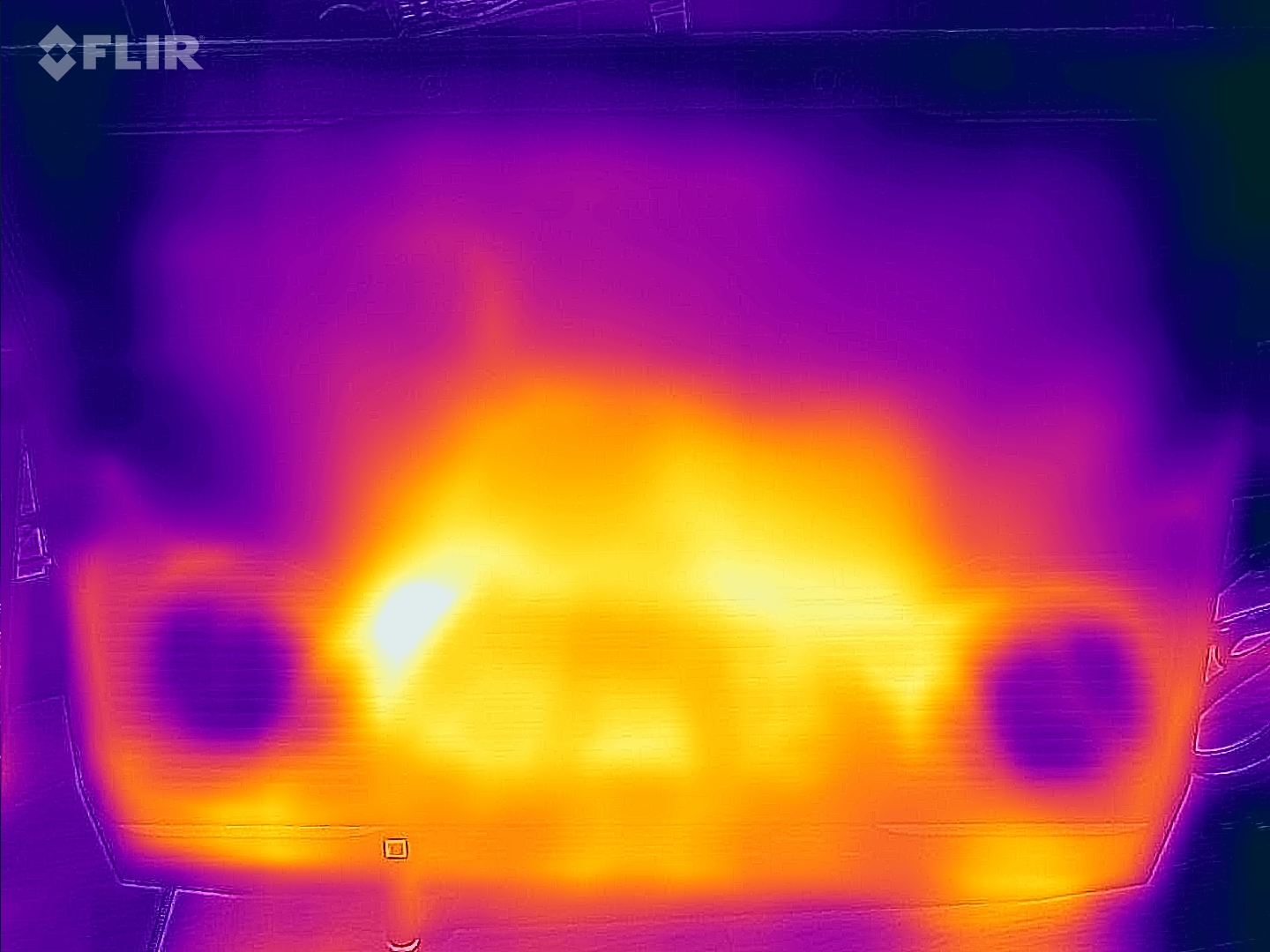
The hottest point on the bottom machine was a toasty 55.1 degrees Celsius (131.18 degrees Fahrenheit), so this is one to definitely keep on your desk. That's toasty.
Webcam on the Dell G16
Dell's 720p webcam on the G16 is fine for casual calls with friends or family. But it's not good.
Images I captured while using the webcam were quite grainy, and sometimes had a bit of blur. While its output is color accurate, down to the blues in my eyes and the multi-colored book spines on a shelf behind me, the pixelation and lack of detail (I swear, it looked like I didn't have eyelashes) bring it down. If this is the machine for your streaming dreams, consider one of the best webcams.
I can't say I'm surprised. While laptops are increasingly moving to higher quality, 1080p sensors (and the two aren't always conflated), mid-level gaming laptops haven't gotten there as a category yet. Maybe it's about time they start.
Software and Warranty on the Dell G16
Dell has a handful of apps pre-loaded in its Windows 11 install, but only one stands out as important: Alienware Command Center. Despite carrying the name of Dell's more luxurious brand, you can use it on the G16 to change RGB lighting colors and launch games from your library.
Other Dell add-ons include My Dell, with access to warranty information, power profiles and support; Dell Customer Connect, which seemingly only exists to feed customers surveys; Dell Update and Dell Digital Delivery for software.
While no third-party antivirus software came preloaded on our machine, a bookmark to McAfee's website came pre-attached to the Edge browser, along with a folder of links to Dell's site. Dell should stop doing this.
There are also some apps that come preinstalled with Windows 11, like Spotify and Disney Plus, which are featured prominently in the Start menu.
Dell sells the G16 with a one-year warranty.
Dell G16 Configurations
We tested the Dell G16 (7620) at $1,499.99 with an Intel Core i7-12700H, Nvidia GeForce RTX 3060, 16GB of RAM and a 512GB M.2 SSD.
As of this writing, there's only one display option: the 16-inch, 2560 x 1600, 165 Hz panel on our review unit.
The base model is $1,139.99, which is identical to what we tested, except with a lesser, GeForce RTX 3050 Ti.
The top-end model is $1,799.99 with an Intel Core i9-12900H Nvidia GeForce RTX 3070 Ti, 32GB of RAM, 1TB of PCIe SSD.
That's all assuming you use the standard, single-zone backlit keyboard. Some configurations with the RTX 3050 Ti or RTX 3070 Ti allow for a Cherry low-profile mechanical keyboard. That's a $50 upgrade on Dell's website.
Bottom Line
Whether bigger is better is a personal choice, but it's one Dell is offering with the G16 (7620). At around $1,500 (give or take a few hundred dollars based on the configuration), its 16:10 aspect ratio is uncommon.
The G16's design is sturdy with its aluminum top cover, and configured the way we reviewed it, with an RTX 3060 and an Intel Core i7-12700H, it did well on our games benchmarks. Some other gaming laptops, like the Asus TUF Gaming F15 were better on productivity, suggesting that they may have better cooling on their processors.
There are still some signs of the Dell G line's budget origins, like a crappy webcam and a stiff touchpad. (Though I imagine most gamers will bring a mouse to the party.) But if you want a 16-inch screen and a decent amount of power for a price that won't break the bank, the G16 is worth checking out.
MORE: How to Buy a Gaming Laptop
MORE: Best Gaming PCs
MORE: Best Ultrabooks and Premium Laptops

Andrew E. Freedman is a senior editor at Tom's Hardware focusing on laptops, desktops and gaming. He also keeps up with the latest news. A lover of all things gaming and tech, his previous work has shown up in Tom's Guide, Laptop Mag, Kotaku, PCMag and Complex, among others. Follow him on Threads @FreedmanAE and BlueSky @andrewfreedman.net. You can send him tips on Signal: andrewfreedman.01
